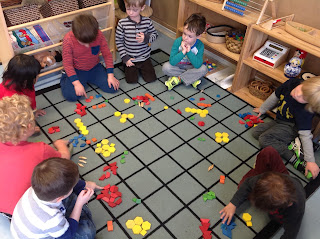"Mathematics instruction is most effective when it is part of a comprehensive approach that pays equal attention to all aspects of a child's development: social/emotional, physical, cognitive, and language. There must be opportunities for children to explore independently and times for direct teaching in small groups, in large groups, and one-on-one. In addition, children practice and use mathematical skills during daily routines and during the active learning that takes place in interest areas." (Mathematics: The Creative Curriculum Approach, pg. ix)
Direct Instruction
(small groups)
Instruction is tailored to meet the needs of small groups of children.
"Educators provide experiences in playing with mathematics itself by using a repertoire of strategies, including open and parallel tasks that provide differentiation to meet the needs of all students and ensure full participation." (Maximizing Student Mathematical Learning in the Early Years, Capacity Building Series, September 2011, Special Edition #22)
Provocations: Exploring, investigating, and experimenting opportunities based on direct instruction content. This allows children to learn at their own level of understanding.
"Honouring children's starting points enables educators to build on students' mathematical knowledge with an inquiry-based approach, developing purposeful and meaningful mathematical experiences in the classroom." (Maximizing Student Mathematical Learning in the Early Years, Capacity Building Series, September 2011, Special Edition #22)
"Honouring children's starting points enables educators to build on students' mathematical knowledge with an inquiry-based approach, developing purposeful and meaningful mathematical experiences in the classroom." (Maximizing Student Mathematical Learning in the Early Years, Capacity Building Series, September 2011, Special Edition #22)
(whole group)
Talking about their thinking with peers. New learning and extensions are made through questions and comments posed by peers and educators. This allows for whole group sharing of knowledge and ideas.
"After students have worked through solving a problem, educators facilitate consolidation time (either with individual students or with small groups or large groups) in order to allow students to talk about their thinking. As educators value a variety of strategies and solutions, they guide students to make connections between them, to recognize how the thinking relates to the key mathematical concept and to make further conjectures and generalizations." (Maximizing Student Mathematical Learning in the Early Years, Capacity Building Series, September 2011, Special Edition #22)
"Teachers can post documentation of math learning as a way of encouraging children to reflect on past experiences and motivate them to plan and revise future ones." (McLennan, D. P. Making Math Meaningful for Young Children. Teaching Young Children, Vol 8, No 1, pg. 21)
Math related books
"Children's literature has been widely described as a tool to provide hands-on opportunities to apply math concepts and skills. Integrating mathematics and literacy creates an interweaving of curriculum rather than a compartmentalizing of academic subjects. Many children's books provide a natural, meaningful path for exploring and exchanging ideas about math concepts." (Cutler, K. M., Gilkerson, D., Parrott, S., and Bowne, M. T. Developing Math Games Based on Children's Literature. National Association for the Education of Young Children, 2003, pg. 1)
For more math related books visit:
Math Read Alouds: Connecting Math and Literacy
By Tracy Pickard and Cheryl Emrich
Inquiries and Projects
Math connections can often be found in many inquiries and projects that are of interest to students. Finding these links allows for authentic and purposeful learning of mathematical concepts.
Routines and natural occurrences
"Educators can play an integral role by making meaningful connections between the mathematical strands, the real world and other disciplines and most importantly, between the intuitive informal mathematics that students have learned through their own experiences and the mathematics they are learning in school" (Ontario Ministry of Education, 2003, p. 14).
Other examples:
-Placing of lunch bags (one per table) for lunch
-Counting the water bottles on our two shelves so there are not more on one shelf than the other and create falls
-Noting the number of people at certain exploration areas
-Sorting materials during clean-up time
-Noting who is tall and short to figuring out who stands or kneels for reflection sharing so that all can see the work shared
Math in play
Finding math related content in children's play can support learning greatly by introducing appropriate math language and concepts purposefully.
"Knowledgeable educators recognize that although young children may have a beginning understanding of mathematical concepts they often lack the language to communicate their ideas. By modelling and fostering math talk throughout the day and across various subject areas, educators can provide the math language that allows students to articulate their ideas." (Maximizing Student Mathematical Learning in the Early Years, Capacity Building Series, September 2011, Special Edition #22)
Benefits of games in the classroom:
- Playing games encourages strategic mathematical thinking as students find different strategies for solving problems and deepen their understanding of numbers.
- When play repeatedly, games support students' development and computational fluency.
- Games present opportunities for practice, often without the need for teachers to provide the problems.
- Games have the potential to allow students to develop familiarity with number system and engage in building a deeper understanding of operations.
More information on games:
Developing Math Games Based on Children's Literature
Playing with Dice
Learning Mathematics Through Games: Series 1. Why Games?
Learning Mathematics Through Games: Series 2. Types of Games
Playing with Dice
Why Play Math Games? (National Council of Teachers of Mathematics)
It all adds up: Learning early math through play and games
Developing Math Games Based on Children's Literature
Playing with Dice
Learning Mathematics Through Games: Series 1. Why Games?
Learning Mathematics Through Games: Series 2. Types of Games
Playing with Dice
Why Play Math Games? (National Council of Teachers of Mathematics)
It all adds up: Learning early math through play and games


































































An abundance of ideas. Thanks for posting Anna Maria and I did notice the lazy Susan!
ReplyDeleteEnjoyed the blog post. I write a blog as well so I like reading about how others are finding their passion.
ReplyDelete